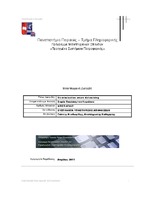| dc.contributor.author | Παυλάκη, Σοφία Κ. | |
| dc.date.accessioned | 2011-09-23T08:13:10Z | |
| dc.date.available | 2011-09-23T08:13:10Z | |
| dc.date.issued | 2011-09-23T08:13:10Z | |
| dc.identifier.uri | https://dione.lib.unipi.gr/xmlui/handle/unipi/4198 | |
| dc.description.abstract | Η παρούσα εργασία σκοπό έχει να μελετήσει την ύπαρξη ή όχι στοιχείων διάκρισης στη χρήση μεθόδων εξόρυξης γνώσης με σκοπό τη λήψη αποφάσεων. Ανάλυση λαμβάνει χώρα σχετικά με τα είδη των διακρίσεων (άμεση και έμμεση), ενώ γίνεται και εκτενής αναφορά στην ισχύουσα νομοθεσία σε σχέση με τις διακρίσεις. Κυρίως η αναφορά σε στοιχεία διάκρισης αναφέρεται στο φύλο, τη φυλή, τη θρησκεία, την ηλικία, την αναπηρία και το σεξουαλικό προσδιορισμό. Μελέτη περίπτωσης για έμμεση και άμεση διάκριση αναλύεται στο δεύτερο κεφάλαιο, ενώ στο τρίτο παρουσιάζονται μέθοδοι με ροπή στις διακρίσεις. Ακολουθεί η εισαγωγή της παραμέτρου α, η οποία βοηθά στον ορισμό ενός ορίου το οποίο μπορεί να χρησιμοποιηθεί για να ελέγξει τη συμπεριφορά με στοιχεία διάκρισης ενάντια σε παραμέτρους που εξετάζονται για τη λήψη αποφάσεων. Τέλος, αναφέρονται οι προβληματισμοί σχετικά με το θέμα, κυρίως αναφορικά με την έλλειψη έρευνας καθώς και στο κατά πόσο τα στοιχεία διάκρισης υπάρχουν στη λήψη αποφάσεων ακούσια ή εκούσια. | |
| dc.language.iso | el | |
| dc.rights | Αναφορά Δημιουργού-Μη Εμπορική Χρήση-Όχι Παράγωγα Έργα 4.0 Διεθνές | |
| dc.rights.uri | http://creativecommons.org/licenses/by-nc-nd/4.0/deed.el | |
| dc.subject | Αποφάσεις, Λήψη των | |
| dc.subject | Εξόρυξη δεδομένων | |
| dc.title | Discrimination aware datamining | |
| dc.type | Master Thesis | |
| europeana.isShownAt | https://dione.lib.unipi.gr/xmlui/handle/unipi/4198 | |
| europeana.type | IMAGE | |
| dc.identifier.call | 006.3 ΠΑΥ | |
| dc.description.abstractEN | Aim of the thesis is to investigate the existence or non-existence of discriminatory elements in data mining methods used for decision support systems. The different types of discrimination are analysed; direct and indirect discrimination, while there is extended reference to the existing law and regulations in relation to discrimination. Mainly discrimination is related to gender, race/nationality, religion, age, disabilities and sexual preferences. Case study for indirect and direct discrimination is analysed in the second chapter, while at the third chapter there is reference to the data mining methods which tend to produce discriminatory results. Parameter α is introduced which assists in definition of a threshold to measure discrimination in decision support. As a last point, considerations are expressed concerning the fact that there is limited research for discrimination in data mining methods as well as concerning the motivation for discrimination. | |



